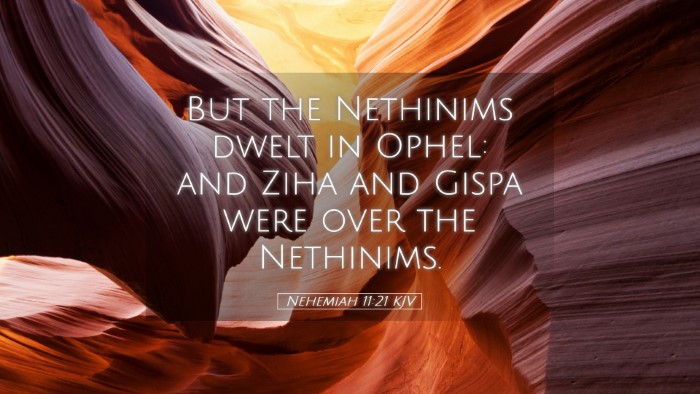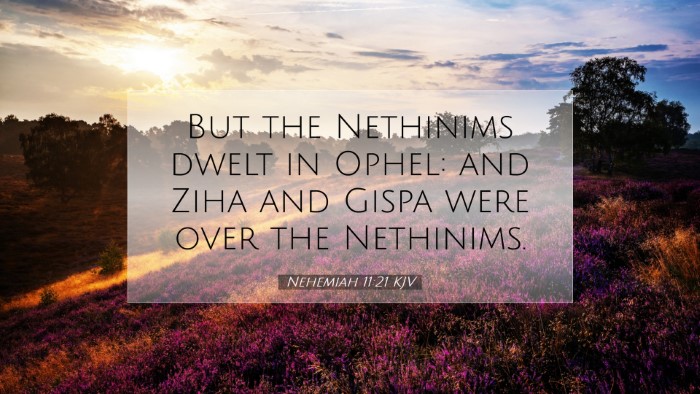Commentary on Nehemiah 11:21
Nehemiah 11:21 states: "But the Nethinim dwelt in Ophel: and Ziha and Gispa were over the Nethinim." This verse provides insights into the social and administrative structure of the Jewish community post-exile. The mention of the Nethinim and their leaders reveals much about their role in the restoration of Jerusalem.
Context and Background
To understand Nehemiah 11:21, we must first consider the historical context. After the Babylonian exile, the Jewish people faced the daunting task of rebuilding their homeland. Nehemiah's leadership facilitated not only physical reconstruction but also the reestablishment of the Jewish community. The Nethinim, mentioned here, were a specific group tasked with serving in the Temple.
The Nethinim: Their Role and Significance
- Definition and Purpose: The Nethinim were essentially temple servants. Their name suggests that they were "given" or "dedicated" to the service of the Temple, possibly originating from the Gibeonites who were incorporated into Israel's religious life (Joshua 9).
- Historical Function: Commentaries such as those by Matthew Henry highlight how the Nethinim were vital for the daily functions of Temple worship. Their work included menial tasks that supported the Levitical priests.
- Leadership Structure: In this passage, specific leaders, Ziha and Gispa, are mentioned over the Nethinim, indicating a structured hierarchy which underscores the importance of organization within the community. Albert Barnes emphasizes that this organization was crucial for effective management and worship practices.
Geographical Note: Ophel
The location of Ophel is also significant as it was situated near the Temple; Adam Clarke notes its proximity stress that the Nethinim's tasks were closely tied to the sacred spaces of worship. This placement shows the community’s commitment to maintaining the sanctity and order necessary for worship practices.
Theological Insights
- Divine Assignment: The mention of the Nethinim being in service can be seen as a reflection of God's ordained order. Matthew Henry asserts that every role in the community, even those that seem lowly, is integral to the divine plan.
- Inclusiveness of Service: The inclusion of the Nethinim serves as an example of how God calls diverse people to serve in His Kingdom. Albert Barnes presents the idea that God values all tasks, which should encourage us to serve faithfully, regardless of our roles.
- Restoration Themes: Nehemiah’s efforts in organizing community structures such as those involving the Nethinim highlight key themes of restoration and renewal in the post-exilic period. It demonstrates how rebuilding was more than physical structures; it involved re-establishing spiritual life.
Applications for Today
For today’s pastors, students, and theologians, Nehemiah 11:21 offers several applications:
- Value of Service: Every member of the church has a role in the body of Christ. Much like the Nethinim, those who serve in unseen or less-glamorous roles are crucial for the church's function.
- Leadership and Accountability: The identification of leaders over groups suggests that accountability and structure in leadership are necessary for healthy ministry. Churches today can learn from this model to support each other and operate effectively.
- Divine Purpose: The task of rebuilding and connecting with God’s work in our communities can reflect God’s call upon our lives. Embracing diverse callings as expressions of divine assignment can transform our understanding of communal and individual service to God.
Conclusion
Nehemiah 11:21 encapsulates a small yet profound narrative concerning the restoration of Israel's identity and worship practices post-exile. Through the structured service of groups like the Nethinim, we see the importance of organization and the integration of all people into God's work. This passage serves as an encouragement to recognize and fulfill our roles today, reflecting on how every service, big or small, contributes to the mission of the church.


